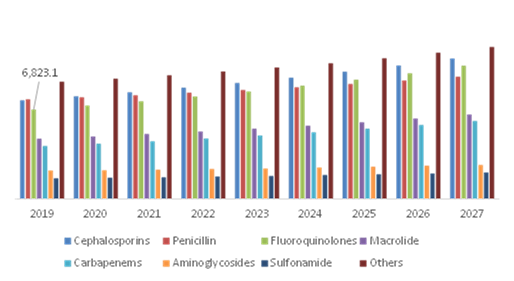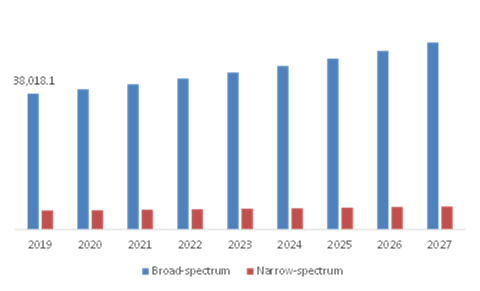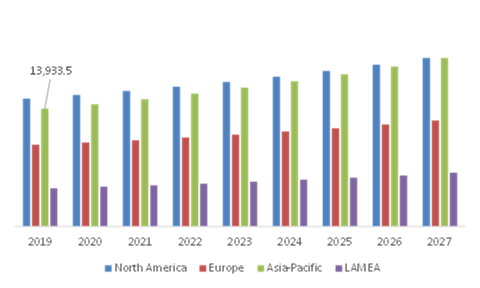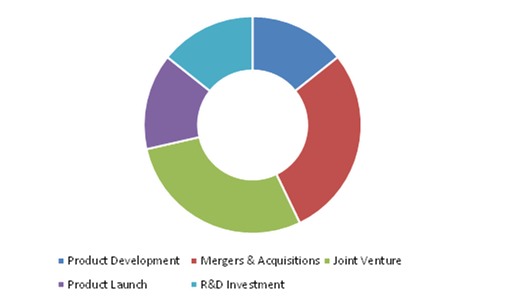Antibiotics Market Report
RA08334
Antibiotics Market, by Drug Class (Cephalosporins, Penicillin, Fluoroquinolones, Macrolide, Carbapenems, Aminoglycosides, Sulfonamide, Others), Spectrum (Broad-spectrum, Narrow-spectrum), Regional Analysis (North America, Europe, Asia Pacific, LAMEA): Global Opportunity Analysis and Industry Forecast, 2020–2027
The global antibiotics market forecast shall be $58,798.1 million by 2027, growing from $43,298.5 million in 2019 at a healthy CAGR of 4.0%. The Asia Pacific antibiotics market is expected to grow at a rate of 4.7% by registering a revenue of $19,932.6 million, over the projected period. Rising prevalence of infections and chronic diseases, supportive government policies, and acquisitions and collaborations by multiple manufacturers for the development of novel drugs are some of the major factors that are accelerating the APAC antibiotics drug market growth.
Antibiotics Market Analysis:
Antibiotics are medicines discovered in the early 20th century as an effective treatment to multiple bacterial infectious diseases, such as wound infections, bacterial pneumonia, and tuberculosis (TB). Antibiotics consists of a broad range of powerful drugs and are used to treat bacterial infections. Infected patients take antibiotics by mouth. Also, doctors can administer antibiotics by injection or apply them directly to the infected body part.
Impact Analysis of COVID-19 on the Global Antibiotics Market:
The outbreak of the novel coronavirus disease (COVID-19) has created a considerable impact on the global antibiotics market. In recent months, the consumption of antibiotics has astonishingly increased due to the need to avoid prolonged illnesses and longer hospital stays amid the COVID-19 pandemic. For instance, as per data published by the FDI (Fédération Dentaire Internationale) World Dental Federation in November 2020, there was an extensive surge in antibiotics prescribed to dental patients in England, amid the COVID-19 outbreak. Moreover, British Dental Journal (BDJ), one of UK's leading dental journal, has witnessed around 25% growth in the prescription of antibiotics by the dentists. Such facts & figures conclude that the demand for antibiotics has increased, in the pandemic, which has created favorable conditions for the global antibiotics market.
The growing prevalence of infectious diseases such as Pneumonia particularly in the developing economies may boost the antibiotics market
The global market for antibiotics is mainly attributed to the novel product innovations for the treatment of severe bacterial infections combined with a large number of clinical trials. In addition to this, the growing prevalence of infectious diseases like pneumonia, HIV/AIDS, tuberculosis, malaria is one of the major factors that will propel the global market growth, during the forecast period. For instance, according to the survey conducted by WHO (World Health Organization) in 2017, pneumonia disease accounted for around 15% of all deaths of children which are under 5 years old. Approximately, 8,08,694 children died in 2017, across the globe. Further, according to the recent analysis from UNICEF (United Nations Children's Fund), severe pneumonia leaves an approximately 4.2 million children (less the age 5) desperate for oxygen in 124 low- and middle-income countries each year. The above figures showcase that the demand for medications is expected to increase and ultimately drive the global antibiotics market.
Furthermore, substantial investments in R&D activities by biotech companies, availability and massive adoption of generic medicines, discovery of advanced molecules, and increasing expenditure in healthcare facilities will be some of the factors that will provide attractive opportunities to the global antibiotics market in the coming years.
To know more about global antibiotics market drivers, get in touch with our analysts here.
The high initial investment may restrain the growth of the global antibiotics industry
Development of antibiotic resistance, particularly in the case of bacterial infections, is one of the major reasons negatively affecting the global antibiotics market. Furthermore, several factors including extensively rising drug approval costs, uncertain government regulatory policies, and fewer companies working in active research are also hampering the market growth.
Incorporation of novel computing technologies for antibiotic discovery may further create positive opportunities for the market
With significant increase in drug resistance in multiple bacteria, new antibiotics are essentially required worldwide. In recent years, technologies such artificial intelligence (AI), machine learning (ML) and deep learning have been providing a platform to develop novel antibiotics to fight against chronic bacterial infections. Machine-learning technology can help to discover new and innovative antibiotics that effectively work against infections such as tuberculosis. Moreover, in February 2020, a team of researchers at Massachusetts Institute of Technology, Cambridge announced that they have introduced halicin, the first discovered antibiotic with AI technology. This antibiotic is highly effective against bacteria such as Acinetobacter baumannii, Mycobacterium tuberculosis, Clostridium difficile, and Pseudomonas aeruginosa. Such recent advancements in the healthcare sector are further expected to offer lucrative market opportunities for the global antibiotics market, in the future.
To know more about global antibiotics market opportunities, get in touch with our analysts here.
Global Antibiotics Market, by Drug Class:
Fluoroquinolones sub-segment for the global antibiotics market will generate a revenue of $10,143.1 million by 2027 with a notable CAGR of 5.2% majorly because of the novel product innovations and their government approvals.
Source: Research Dive Analysis
The fluoroquinolones drug class will grow at a notable CAGR of 5.2% and is expected to register a revenue of $10,143.1 million by 2027, increasing from $6,823.1 million in 2019.
Fluoroquinolones are extremely effective antibiotics with multiple beneficial pharmacokinetic properties such as large volume of distribution and broad-spectrum antimicrobial activity. Furthermore, novel product innovations and their government approvals is a key factor fueling the market growth of the sub-segment. For example, in March 2020, the U.S. Food & Drug Administration’s Center for Veterinary Medicine (FDA-CVM) made an announcement that it has granted approval for marbofloxacin based tablets, ‘Marboquin’. Marbofloxacin is a fluoroquinolone class of antibiotics. These tablets are developed for the treatment of infections in cats and dogs. Also, in June 2017, the U.S. FDA announced that they have given approval for Baxdela. Baxdela is a fluoroquinolone that exhibits activity against both gram-negative pathogens and gram-positive ones. Moreover, the antibiotic is highly effective over acute bacterial skin and skin structure infections (ABSSSI) especially in adults. These notable factors are further expected to upsurge the fluoroquinolones sub-segment growth, during the forecast period.
Global Antibiotics Market, by Spectrum:
The broad-spectrum antibiotics sub-segment will have significant market share and is expected grow exponentially owing to the increasing prevalence of multiple infections including TB, pneumonia, and malaria worldwide.
Source: Research Dive Analysis
The broad-spectrum antibiotics sub-segment of the global antibiotics market will have rapid growth and it is expected to surpass $52,366.7 million by 2027, with the rise from $38,018.1 million in 2019, at a healthy CAGR of 4.2%. The rising prevalence of infectious diseases, major development of innovative antibiotics, and extensively increasing healthcare expenditure in the countries like India, Brazil, and Singapore are some of the primary factors driving the sub-segment, in the forecast period. For instance, in March 2020, Indian government made an announcement that it will endorse common infrastructure facilities in 3 'Bulk Drug Parks' with the investment of around $1.35 billion in the coming 5 years. Furthermore, established as well as startup companies are also coming up with strategic investments in order to strengthen their footprint in the global marketplace. For example, in April 2020, three institutions namely Global Brain Corporation, Japan, University of Tokyo Edge Capital, Japan, and Acquipharma Holdings, South-Africa supported Bugworks Research Inc, a pioneer in novel broad-spectrum antibiotics, with the aid of $7.5 million financing, as announced by Bugworks Research Inc. Further, in November 2020, CARB-X, a global non-profit partnership, led by Boston University, announced that it is officially awarding up to $2.91 million to Evotec SE, a Germany-based drug discovery and development company, to fund the early development of innovative antibiotics. As per this agreement, Evotec SE has proposed to develop a new class of broad-spectrum antibiotics in order to discover treatment over multidrug-resistant bacterial infections. Such effective financial support is expected to foster the sub-segment growth, over the projected period.
Regional Insights:
Asia Pacific antibiotics market has shown a significant growth and it will reach up to $19,932.6 million by the end of 2027
Source: Research Dive Analysis
Asia-Pacific antibiotics market share is projected to increase at a CAGR of 4.7% by generating a revenue of $19,932.6 million by 2027. Asia-Pacific is expected to witness high growth rate in the upcoming years owing to supportive government strategies for antibiotics development. For instance, in 2018, Pfizer collaborated with Indian Council of Medical Research (ICMR) to develop and research new classes of antibiotics to tackle antimicrobial resistance in India. Such type of government support and initiatives will exponentially increase the market growth, which will eventually foster the Asia-Pacific antibiotic market, in the upcoming years.
North America market for antibiotics accounted $15,132.8 million in 2019 and it is estimated to generate a revenue of $19,950.2 million by the end of 2027.
Higher extent of prescribed antibiotics along with strict government & industry regulations for business processes are some of the factors propelling the antibiotics market growth in the region. Furthermore, the strong presence of leading antibiotics manufacturers including Abbott., Merck KGaA, and others will be one of the key factors for the North America’s antibiotics market growth in the near future. Also, these players are opting for effective strategies such as strategic collaborations and product launches to stronghold their presence into local as well as international market. For instance, in January 2018, Melinta Therapeutics, an American company, launched Baxdela (delafloxacin), which is an oral antibiotic for the treatment of bacterial infection skin structure infections and acute bacterial skin and skin structure infection (ABSSSI). Such crucial factors and company developments show that the North America antibiotics market will have a dominating share in 2027.
Competitive Scenario in the Global Antibiotics Market:
The advanced technology development coupled with mergers & acquisitions are the frequent strategies followed by the significant market players
Source: Research Dive Analysis
Some of the significant antibiotics market players include Abbott., Sanofi, Merck KGaA, Bristol-Myers Squibb Company, Janssen Global Services, LLC, GlaxoSmithKline plc., Novartis AG, Bayer AG, Eli Lilly and Company., and Astellas Pharma Inc.
Antibiotics market players are focusing on merger & acquisition and advanced technological developments in order to acquire prominent position in the international market. For example, in July 2020, Novartis AG made an announcement that they are planning for joint investment with Austrian government to help strengthen the future of antibiotics manufacturing in Europe.
Porter’s Five Forces Analysis for Antibiotics Market:
- Bargaining Power of Suppliers: The availability of raw material suppliers is high in the global market, and these supplier companies are huge volume producers which eventually minimizes the bargaining power of suppliers.
Hence, the bargaining power of the supplier is LOW
- Bargaining Power of Buyer: Drug manufacturers hold patents for particular antibiotics. Therefore, the buyers cannot negotiate in drug pricing.
Hence, the bargaining power of buyers is LOW
- Threat of New Entrants: There are high entry barriers owing to the costs associated with R&D innovations of new drugs. Moreover, patent and generic antibiotics require detail government regulation (i.e. FDA). Hence the threat of new entrants will be LOW.
- Threat of Substitutes: In recent years, doctors and therapists have been recommending traditional medicines and herbal products mainly because they are available with zero-side effects.
Thus, the threat of substitutes is MODERATE
- Competitive Rivalry in the Market: The competitive rivalry in the market players is rather intense, particularly between the giant-drug manufacturers like Sanofi, Abbott, and GSK. Such players are successfully launching their value-added products and services in the global market and strengthening the footprint in the marketplace.
Competitive rivalry in the market is HIGH
| Aspect | Particulars |
| Historical Market Estimations | 2018-2019 |
| Base Year for Market Estimation | 2019 |
| Forecast timeline for Market Projection | 2020-2027 |
| Geographical Scope | North America, Europe, Asia-Pacific, LAMEA |
| Segmentation by Drug Class |
|
| Segmentation by Spectrum |
|
| Key Countries Covered | The U.S., Canada, Mexico, Germany, France, UK, Italy, Spain, Rest of Europe, China, Australia, Japan, India, South Korea, Rest of Asia-Pacific, Latin America, Middle East, and Africa
|
| Key Companies Profiled |
|
Q1. What is the size of the global antibiotics market?
A. The global antibiotics market size was over $43,298.5 million in 2019 and is projected to reach $58,798.1 million by 2027.
Q2. Which are the major companies in the antibiotics market?
A. Abbott., Sanofi, Merck KGaA, and Bristol-Myers Squibb Company are some of the key players in the global antibiotics market.
Q3. Which region possesses greater investment opportunities in the coming future?
A. The Asia-Pacific region possesses great investment opportunities for investors to witness the most promising growth in the future.
Q4. What is the growth rate of the Asia-Pacific antibiotics Market?
A. Asia-Pacific antibiotics market is anticipated to grow at 4.7% CAGR during the forecast period.
Q5. What are the strategies opted by the leading players in this market?
A. Technological development and strategic partnerships are the key strategies opted by the operating companies in this market.
Q6. Which companies are investing more on R&D practices?
A. Janssen Global Services, LLC, and GlaxoSmithKline plc. companies are investing more on R&D activities for developing new products and technologies.
1.Research Methodology
1.1.Desk Research
1.2.Real time insights and validation
1.3.Forecast model
1.4.Assumptions and forecast parameters
1.4.1.Assumptions
1.4.2.Forecast parameters
1.5.Data sources
1.5.1.Primary
1.5.2.Secondary
2.Executive Summary
2.1.360° summary
2.2.By drug class trends
2.3.By spectrum trends
3.Market overview
3.1.Market segmentation & definitions
3.2.Key takeaways
3.2.1.Top investment pockets
3.2.2.Top winning strategies
3.3.Porter’s five forces analysis
3.3.1.Bargaining power of consumers
3.3.2.Bargaining power of suppliers
3.3.3.Threat of new entrants
3.3.4.Threat of substitutes
3.3.5.Competitive rivalry in the market
3.4.Market dynamics
3.4.1.Drivers
3.4.2.Restraints
3.4.3.Opportunities
3.5.Technology landscape
3.6.Regulatory landscape
3.7.Patent landscape
3.8.Pricing overview
3.8.1.by drug class type
3.8.2.by spectrum type
3.9.Market value chain analysis
3.9.1.Stress point analysis
3.9.2.Raw material analysis
3.9.3.Manufacturing process
3.9.4.Distribution channel analysis
3.9.5.Operating vendors
3.9.5.1.Raw material suppliers
3.9.5.2.Product manufacturers
3.9.5.3.Product distributors
3.10.Strategic overview
4.Antibiotics Market, by Drug Class
4.1.Cephalosporins
4.1.1.Market size and forecast, by region, 2019-2027
4.1.2.Comparative market share analysis, 2019 & 2027
4.2.Penicillin
4.2.1.Market size and forecast, by region, 2019-2027
4.2.2.Comparative market share analysis, 2019 & 2027
4.3.Fluoroquinolones
4.3.1.Market size and forecast, by region, 2019-2027
4.3.2.Comparative market share analysis, 2019 & 2027
4.4.Macrolide
4.4.1.Market size and forecast, by region, 2019-2027
4.4.2.Comparative market share analysis, 2019 & 2027
4.5.Carbapenems
4.5.1.Market size and forecast, by region, 2019-2027
4.5.2.Comparative market share analysis, 2019 & 2027
4.6.Aminoglycosides
4.6.1.Market size and forecast, by region, 2019-2027
4.6.2.Comparative market share analysis, 2019 & 2027
4.7.Sulfonamide
4.7.1.Market size and forecast, by region, 2019-2027
4.7.2.Comparative market share analysis, 2019 & 2027
4.8.Others
4.8.1.Market size and forecast, by region, 2019-2027
4.8.2.Comparative market share analysis, 2019 & 2027
5.Antibiotics Market, by Spectrum
5.1.Broad-spectrum
5.1.1.Market size and forecast, by region, 2019-2027
5.1.2.Comparative market share analysis, 2019 & 2027
5.2.Narrow-spectrum
5.2.1.Market size and forecast, by region, 2019-2027
5.2.2.Comparative market share analysis, 2019 & 2027
6.Antibiotics Market, by Region
6.1.North America
6.1.1.Market size and forecast, by drug class, 2019-2027
6.1.2.Market size and forecast, by spectrum, 2019-2027
6.1.3.Comparative market share analysis, 2019 & 2027
6.1.4.U.S.
6.1.4.1.Market size and forecast, by drug class, 2019-2027
6.1.4.2.Market size and forecast, by spectrum, 2019-2027
6.1.4.3.Comparative market share analysis, 2019 & 2027
6.1.5.Canada
6.1.5.1.Market size and forecast, by drug class, 2019-2027
6.1.5.2.Market size and forecast, by spectrum, 2019-2027
6.1.5.3.Comparative market share analysis, 2019 & 2027
6.1.6.Mexico
6.1.6.1.Market size and forecast, by drug class, 2019-2027
6.1.6.2.Market size and forecast, by spectrum, 2019-2027
6.1.6.3.Comparative market share analysis, 2019 & 2027
6.2.Europe
6.2.1.Market size and forecast, by drug class, 2019-2027
6.2.2.Market size and forecast, by spectrum, 2019-2027
6.2.3.Market size and forecast, by country, 2019-2027
6.2.4.Comparative market share analysis, 2019 & 2027
6.2.5.Germany
6.2.5.1.Market size and forecast, by drug class, 2019-2027
6.2.5.2.Market size and forecast, by spectrum, 2019-2027
6.2.5.3.Comparative market share analysis, 2019 & 2027
6.2.6.UK
6.2.6.1.Market size and forecast, by drug class, 2019-2027
6.2.6.2.Market size and forecast, by spectrum, 2019-2027
6.2.6.3.Comparative market share analysis, 2019 & 2027
6.2.7.France
6.2.7.1.Market size and forecast, by drug class, 2019-2027
6.2.7.2.Market size and forecast, by spectrum, 2019-2027
6.2.7.3.Comparative market share analysis, 2019 & 2027
6.2.8.Spain
6.2.8.1.Market size and forecast, by drug class, 2019-2027
6.2.8.2.Market size and forecast, by spectrum, 2019-2027
6.2.8.3.Comparative market share analysis, 2019 & 2027
6.2.9.Italy
6.2.9.1.Market size and forecast, by drug class, 2019-2027
6.2.9.2.Market size and forecast, by spectrum, 2019-2027
6.2.9.3.Comparative market share analysis, 2019 & 2027
6.2.10.Rest of Europe
6.2.10.1.Market size and forecast, by drug class, 2019-2027
6.2.10.2.Market size and forecast, by spectrum, 2019-2027
6.2.10.3.Comparative market share analysis, 2019 & 2027
6.3.Asia Pacific
6.3.1.Market size and forecast, by drug class, 2019-2027
6.3.2.Market size and forecast, by spectrum, 2019-2027
6.3.3.Comparative market share analysis, 2019 & 2027
6.3.4.China
6.3.4.1.Market size and forecast, by drug class, 2019-2027
6.3.4.2.Market size and forecast, by spectrum, 2019-2027
6.3.4.3.Comparative market share analysis, 2019 & 2027
6.3.5.India
6.3.5.1.Market size and forecast, by drug class, 2019-2027
6.3.5.2.Market size and forecast, by spectrum, 2019-2027
6.3.5.3.Comparative market share analysis, 2019 & 2027
6.3.6.Australia
6.3.6.1.Market size and forecast, by drug class, 2019-2027
6.3.6.2.Market size and forecast, by spectrum, 2019-2027
6.3.6.3.Market size and forecast, by organization size, 2019-2027
6.3.6.4.Market size and forecast, by vertical, 2019-2027
6.3.6.5.Comparative market share analysis, 2019 & 2027
6.3.7.Rest of Asia Pacific
6.3.7.1.Market size and forecast, by drug class, 2019-2027
6.3.7.2.Market size and forecast, by spectrum, 2019-2027
6.3.7.3.Comparative market share analysis, 2019 & 2027
6.4.LAMEA
6.4.1.Market size and forecast, by drug class, 2019-2027
6.4.2.Market size and forecast, by spectrum, 2019-2027
6.4.3.Market size and forecast, by country, 2019-2027
6.4.4.Comparative market share analysis, 2019 & 2027
6.4.5.Latin America
6.4.5.1.Market size and forecast, by drug class, 2019-2027
6.4.5.2.Market size and forecast, by spectrum, 2019-2027
6.4.5.3.Comparative market share analysis, 2019 & 2027
6.4.6.Middle East
6.4.6.1.Market size and forecast, by drug class, 2019-2027
6.4.6.2.Market size and forecast, by spectrum, 2019-2027
6.4.6.3.Comparative market share analysis, 2019 & 2027
6.4.7.Africa
6.4.7.1.Market size and forecast, by drug class, 2019-2027
6.4.7.2.Market size and forecast, by spectrum, 2019-2027
6.4.7.3.Comparative market share analysis, 2019 & 2027
7.Company profiles
7.1.Abbott.
7.1.1.Business overview
7.1.2.Financial performance
7.1.3.Product portfolio
7.1.4.Recent strategic moves & developments
7.1.5.SWOT analysis
7.2.Sanofi
7.2.1.Business overview
7.2.2.Financial performance
7.2.3.Product portfolio
7.2.4.Recent strategic moves & developments
7.2.5.SWOT analysis
7.3.Merck KGaA
7.3.1.Business overview
7.3.2.Financial performance
7.3.3.Product portfolio
7.3.4.Recent strategic moves & developments
7.3.5.SWOT analysis
7.4.Bristol-Myers Squibb Company
7.4.1.Business overview
7.4.2.Financial performance
7.4.3.Product portfolio
7.4.4.Recent strategic moves & developments
7.4.5.SWOT analysis
7.5.Janssen Global Services, LLC
7.5.1.Business overview
7.5.2.Financial performance
7.5.3.Product portfolio
7.5.4.Recent strategic moves & developments
7.5.5.SWOT analysis
7.6.GlaxoSmithKline plc.
7.6.1.Business overview
7.6.2.Financial performance
7.6.3.Product portfolio
7.6.4.Recent strategic moves & developments
7.6.5.SWOT analysis
7.7.Novartis AG
7.7.1.Business overview
7.7.2.Financial performance
7.7.3.Product portfolio
7.7.4.Recent strategic moves & developments
7.7.5.SWOT analysis
7.8.Bayer AG
7.8.1.Business overview
7.8.2.Financial performance
7.8.3.Product portfolio
7.8.4.Recent strategic moves & developments
7.8.5.SWOT analysis
7.9.Eli Lilly and Company.
7.9.1.Business overview
7.9.2.Financial performance
7.9.3.Product portfolio
7.9.4.Recent strategic moves & developments
7.9.5.SWOT analysis
7.10.Astellas Pharma Inc.
7.10.1.Business overview
7.10.2.Financial performance
7.10.3.Product portfolio
7.10.4.Recent strategic moves & developments
7.10.5.SWOT analysis
It was Alexander Fleming who first discovered penicillin, a type of antibiotic, in the year 1928. Antibiotics are type of medicine that stops infections that are caused by any bacteria by killing or inhibiting the growth of the microbes. The literal meaning of antibiotic is ‘against life’, thus this medicine aids in killing all harmful bacteria in the body. In addition, only bacterial infections can be cured with the help of antibiotics but these are ineffective against viral infections such as bronchitis or common cold. A doctor may prescribe antiviral drugs for viral diseases. Some of the diseases that are treated effectively by antibiotics are skin infections, strep throat, meningitis, whooping cough, bacterial pneumonias, kidney infections, and other bacterial diseases.
Forecast Analysis of Antibiotics Market
The antibiotics market is expected to enhance at a massive rate in the upcoming years due to new product inventions for treating crucial bacterial infections. For instance, in September 2020, Shionogi, a pharmaceutical company, has launched Fetcroja drug in the United Kingdom. This drug is first of its kind that provides protection against all Gram-Negative pathogens. Another reason for the market growth is the rising prevalence of infectious diseases such as HIV/AIDS, pneumonia, and tuberculosis. For example, in 2017, WHO (World Health Organization) conducted a survey in which it was noted that around 15% of children died due to pneumonia. Apart from this, heavy investments in research & development by the biotech companies and rise in the expenditure in the healthcare sector are predicted to open up lucrative opportunities for the global market in the recent years.
Beyond this, implementation of computing technology such as artificial intelligence and machine learning in discovering novel and innovative antibiotics is anticipated to increase the global market growth. However, development of resistance against the antibiotics by pathogens is predicted to hamper the market growth in the upcoming years. As per a report published by Research Dive, the global antibiotics market [ca1] is estimated to reach $58,798.1 million by 2027. Furthermore, the market of the Asia-Pacific region is likely to gain significant growth due to government support for developing antibiotics.
Newest Developments of the Antibiotics Market
The leading players of the global antibiotics market are opting for unique strategies such as mergers & acquisitions, new product announcements, building product portfolios, fund raising for projects, and investments in research & development projects. These strategies are helping the companies in gaining edge in the global market.
In January 2020, Wockhardt, a pharmaceutical company based in Mumbai, India, has received approval by the drug regulator to launch two new antibiotics. The DCGI (Drug Controller General of India) has approved Emrok O (oral) and Emrok (injectable) which will be developed by Wockhardt.
In November 2020, MSD (Merck & Co), has launched a new antibiotic Recarbrio in the United Kingdom after gaining the approval by the European Commission.
In July 2020, AMR (Antimicrobial Resistance Research) Action Fund has been set up by 20 pharmaceutical companies such as Almirall, Bayer, and Chugai to name a few, in order to invest $1 billion in biotech companies for developing antibiotics against resistant bacteria.
Covid-19 Impact on Antibiotics Market
The global antibiotics market is estimated to surge significantly during the Covid-19 pandemic due to rise in the consumption of antibiotics at an astonishing rate. People prefer antibiotics to avoid long-term illness and prolonged hospital stays during the coronavirus outbreak. For example, in a data published by World Dental Federation in November 2020, a rise in antibiotics prescription was noted in England during the Covid-19 mayhem. This indicates that the antibiotics market is likely to face positive growth during the pandemic phase.
Future Scope of the Market
Antibiotics play a vital role in our lives as they help in fighting off infectious pathogens that otherwise may lead to death. Therefore, the antibiotics market seems to be where one can bet on the right horse and expect full filled returns as well. Apart from this, the global epidemic of the novel coronavirus disease has made it evident for pharmaceutical companies to finance heavily in the field of medicine, thus opening opportunities in the global market in the upcoming years.
Personalize this research
- Triangulate with your own data
- Request your format and definition
- Get a deeper dive on a specific application, geography, customer or competitor
- + 1-888-961-4454 Toll - Free
- support@researchdive.com





